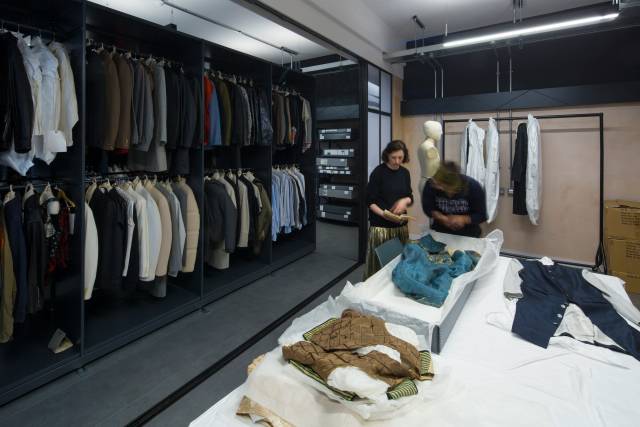Project framework: context, research questions, summary of research insights
The project comprises both the Westminster Menswear Archive (WMA) – launched in 2016 – and Invisible Men, the exhibition. As the UK’s largest exhibition devoted to menswear, the latter showcased more than 170 garments, many of which had never been on public display, to explore the past 120 years of British menswear. The show drew exclusively on the archive, a significant new fashion and dress research and teaching collection established by Andrew Groves and funded by the Quintin Hogg Trust (competitive award).
The exhibition examined the material design language of menswear, which focuses predominantly on the replication of archetypal functional garments intended for specific industrial, technical or military use. It addressed the historical omission of menswear both in collections of dress and within fashion exhibitions, and how this absence denies opportunities to understand male dress and masculinities. Two early exhibitions, Archetypes (2015) and The Vanishing Art of Camouflage (2016), allowed Groves to test hypotheses regarding the distinctiveness of menswear’s inherent design methodology.
The WMA is underpinned by a distinct nonhierarchical approach to the collection and taxonomy of cloth-based objects, challenging the orthodoxy of traditional approaches to dress history, proposing instead a parity of objects, by interspersing workwear, uniforms and designer garments.
Context
This project draws on recent research examining the history of the collection of dress and its display within museums. Exhibiting Fashion: Before and After 1971 (Clark and Haye, 2013) explores the watershed Victoria & Albert Museum show Fashion: An Anthology by Cecil Beaton (1971) and its importance in the establishment of the national collection of textiles and fashion, and in doing so setting precedents to collection policies and reinforcing existing hierarchies around gender and class within the field.
The project also draws on the paper ‘An incomplete inventory of fashion exhibitions since 1971’ (Horsley, 2014), and Petrov’s research in the chapter ‘Gender considerations in fashion history exhibitions’ (2014). Additionally, it builds on the work of Wilcox, senior curator of fashion at the V&A, and her investigation into the building of the national collection of textiles and fashion at the museum (2018). This research exposed a significant gap in knowledge within the collection, study and curation of menswear. Historically, object-based research within the studies of dress has predominantly focused on womenswear as a means of understanding the fashioned body, with, by comparison, far less research undertaken using menswear (Breward, 1999; Mida and Kim, 2015)
This project is situated within the practices and conventions of dress history (the study of clothing within its historical context) and the fashion exhibition. Despite the exponential growth in fashion exhibitions over the past 50 years, menswear largely remains marginalised or excluded from the history of dress. Horsley has described this scarcity of menswear within exhibitions as the ‘Absent Shadow’ (Horsley, 2017). Exhibitions of menswear have tended to concentrate on the fashionable figure of the dandy with an emphasis on the unusual and visually spectacular, such as Rhode Island School of Design Museum’s Artist Rebel Dandy (Irvin and Brewer, 2013). Moreover, within museums of the decorative arts and dedicated fashion collections, menswear, both as material culture and a design process, has been significantly underrepresented (Taylor, 2002).
Invisible Men references and draws comparisons with the V&A’s ground-breaking exhibition Fashion: An Anthology by Cecil Beaton (1971), which created a seismic shift in the way fashion was presented within a museum context. It was the forerunner to the modern blockbuster fashion exhibitions such as Fashion and Surrealism, London (1988), Streetstyle: From Sidewalk to Catwalk, London (1994), Radical Fashion, London (2001), Alexander McQueen: Savage Beauty, New York (2011), London (2015), and Christian Dior: Designer of Dreams, Paris (2017).
However, menswear has been significantly underrepresented or excluded from such exhibitions. For example, despite McQueen’s training in men’s tailoring on Savile Row, no menswear was included in Alexander McQueen: Savage Beauty (2011), while Christian Dior (2017) focused solely on womenswear despite the label introducing a men’s line in the 1970s and their ground-breaking menswear under designers Hedi Slimane and Kim Jones. A notable exception was LACMA’s Reigning Men: Fashionable Menswear 1715 – 2015 (2015).
Through the formation of the Westminster Menswear Archive, in 2016, and the exhibition Invisible Men, this project sought to redress the imbalance of the majority of collections of dress and their presentation. In doing so, the project creates new knowledge within the discipline of fashion history and proposes new ways of researching and curatorial practice by rejecting a conventional hierarchy of design and challenging the orthodoxy of traditional dress collections and exhibitions.
Key questions
The research explores:
1 How the aesthetics and design process of menswear might make it resistant to investigation in comparison to womenswear.
2 The ways in which archetypal menswear garments (industrial, military, designer) are reinterpreted to create new design outcomes.
3 How the relationship between these gendered cloth-based artefacts gives them status and meaning.
Summary of research insights
Groves’ distinctive non-hierarchical approach to the development of the Westminster Menswear Archive paved the way for the Invisible Men exhibition to explore the design language of menswear and expose its reliance on a fundamentally unquestioning reworking of archetypal functional garments of “the working man”.
| Creators | Groves, Andrew |
|---|---|
| Description | Groves led the project to establish and launch the WMA in 2016, with the purpose of redressing the historical omission |
| Portfolio items | Invisible Men: An Anthology from the Westminster Menswear Archive |
| Invisible Men Conference | |
| Invisible Men: An Anthology from the Westminster Menswear Archive | |
| Year | 2019 |
| Publisher | University of Westminster |
| Web address (URL) | https://www.invisiblemenexhibition.com/ |
| Keywords | CREAM Portfolio |
| Digital Object Identifier (DOI) | https://doi.org/10.34737/qqq4v |

